Click on images to enlarge
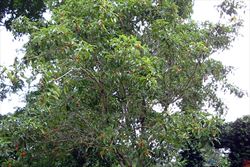
habit in fruit (Photo: Sheldon Navie)
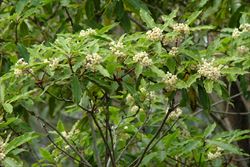
habit in flower (Photo: Sheldon Navie)

shiny green leaves with wavy margins (Photo: Sheldon Navie)
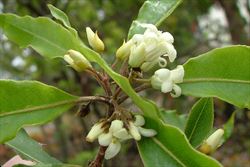
flower buds and young flowers (Photo: Sheldon Navie)

cluster of flowers (Photo: Sheldon Navie)
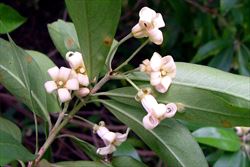
leaf undersides, younger stems and flowers (Photo: Sheldon Navie)
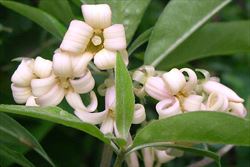
close-up of young leaves and flowers with reflexed petals (Photo: Sheldon Navie)

young fruit (Photo: Sheldon Navie)
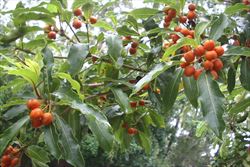
clusters of immature fruit (Photo: Sheldon Navie)
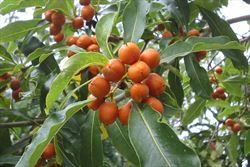
orange immature fruit (Photo: Sheldon Navie)

close-up of mature fruit that have opened and are releasing their sticky seeds (Photo: Sheldon Navie)

close-up of seeds (Photo: Steve Hurst at USDA PLANTS Database)
Scientific Name
Pittosporum undulatum Vent.
Family
Pittosporaceae
Common Names
Australian cheesewood, Australian daphne, Australian mock orange, cheesewood, mock orange, native daphne, native orange, orange pittosporum, orange-berry pittosporum, pittosporum, snowdrop tree, sweet pittosporum, Victorian box, Victorian laurel, wild coffee
Origin
Native to the coastal and sub-coastal districts of eastern Australia (i.e. south-eastern and central Queensland, eastern New South Wales, the ACT and eastern Victoria).
Cultivation
Sweet pittosporum (Pittosporum undulatum) has been widely cultivated as a garden ornamental in eastern and southern Australia.
Naturalised Distribution
Widely naturalised naturalised beyond its native range in southern Australia (i.e. in south-western Western Australia, in Tasmania, in south-eastern South Australia and beyond its native range in Victoria). It is also naturalised on Lord Howe Island and Norfolk Island. It is also thought to have invaded habitats that it did not previously occupy within its native range in New South Wales.
Naturalised overseas in southern Europe (i.e. France, Spain and Portugal), southern Africa (i.e. South Africa), Saint Helena, India, China, New Zealand, south-western USA (i.e. California), Mexico, the Caribbean, South America (i.e. Colombia, Bolivia and Chile) and Hawaii.
Habitat
In its natural habitat it grows in rainforests and wet sclerophyll forests and in sheltered situations in dry sclerophyll forests and woodlands.
This species is a weed of open woodlands, grasslands, coastal environs, gardens, roadsides, urban bushland, closed forests, and riparian vegetation in temperate and sub-tropical and regions.
Habit
A large evergreen shrub or tree usually growing 4-14 m tall, but capable of growing up to 20 m in height.
Distinguishing Features
- a large evergreen shrub or tree usually growing 4-14 m tall.
- its glossy leaves are entire with wavy margins and are alternately arranged or clustered at the tips of the branches.
- its bell-shaped creamy-white flowers (1-2 cm long) are borne in small clusters (4-5 in number) at the ends of the branches.
- these flowers and have five petals that are bent backwards at the tips.
- separate male and female flowers are usually borne on different plants.
- its distinctive hard orange capsules (about 10 mm across) split open when ripe to expose 20-30 sticky seeds.
Stems and Leaves
The older stems are covered in a smooth light grey to brownish-coloured bark. Younger shoots are hairless (i.e. glabrous) or slightly hairy (i.e. puberulent) and green or reddish-brown in colour.
The leaves are borne on stalks (i.e. petioles) 12-15 mm long and are smooth and glossy in appearance. They are hairless (i.e. glabrous) with entire but wavy (i.e. undulate) margins. These leaves (5-15 cm long and 1.5-5 cm wide) are narrowly oblong (i.e. oblanceolate), oval (i.e. elliptic) or egg-shaped in outline (i.e. ovate) and are alternately arranged or clustered at the tips of the branches. They have dark green upper surfaces with paler undersides and pointed tips (i.e. acute to acuminate apices).
Flowers and Fruit
The creamy-white flowers (10-20 mm long) are strongly scented and borne in small clusters (containing 4-5 flowers) at the tips of the branches. They are bell-shaped (i.e. tubular) with five petals (10-12 mm long) that are fused together at the base in to a tube (i.e. corolla tube). The petal lobes are bent backwards (i.e. reflexed) at their tips. The flowers also have five green sepals (6-10 mm long), five stamens, and a hairy ovary topped with a short style. Flowering occurs mostly from late winter through to late spring.
The hard fruit are rounded (i.e. globular) or slightly flattened (i.e. sub-globular or obovate) capsules. These fruit (10-16 mm long and about 10 mm across) contain 20-30 seeds and turn from green to yellow then orange as they ripen. When fully ripe the fruit splits open to release its seeds, and eventually turns brown in colour. The sticky angular seeds (about 3 mm long and 1 mm thick) are smooth in texture and reddish-brown or brownish when mature.
Reproduction and Dispersal
This species reproduces by seed and suckers.
Seeds are eaten and spread by fruit-eating (i.e. frugivorous) birds. They are also dispersed by sticking to birds, other animals and clothing and are sometimes spread in dumped garden waste.
Environmental Impact
Sweet pittosporum (Pittosporum undulatum) is regarded as a significant environmental weed in Victoria, South Australia, Tasmania, New South Wales, Western Australia and on Lord Howe Island. It was also recently listed as a priority environmental weed in four Natural Resource Management regions, and appears in the Global Invasive Species Database (GISD).
Legislation
This species is declared under legislation in the following states and territories:
- New South Wales: Class 3 - a regionally controlled weed. The relevant local control authority must be promptly notified of the presence of this weed and it must be fully and continuously suppressed and destroyed (on Lord Howe Island only).
- Western Australia: Unassessed - this species is declared in other states or territories and is prohibited until assessed via a weed risk assessment (throughout the entire state).
Similar Species
Sweet pittosporum (Pittosporum undulatum) can be confused with other native species such as diamond-leaved pittosporum (Auranticarpa rhombifolia) and brush muttonwood (Rapanaea howittiana). These species can be separated by the following differences:
- sweet pittosporum (Pittosporum undulatum) has leaves with entire margins and relatively large creamy white flowers (1-2 cm long). Its fruit are relatively large orange capsules (10-15 mm across) that split open when mature.
- diamond-leaved pittosporum (Auranticarpa rhombifolia) has leaves with toothed (i.e. serrate) margins (rarely entire) and relatively small white flowers (6-8 mm long). Its fruit are relatively small orange capsules (4-6 mm across) that split open when mature.
- brush muttonwood (Rapanea howittiana) has leaves with entire margins and tiny creamy white flowers. Its fruit are relatively small blue or purplish 'berries' (5-7 mm across) that do not split open when mature.
Sweet pittosporum (Pittosporum undulatum) also hybridises with banyalla (Pittosporum bicolor), and this hybrid is intermediate between the two species.

